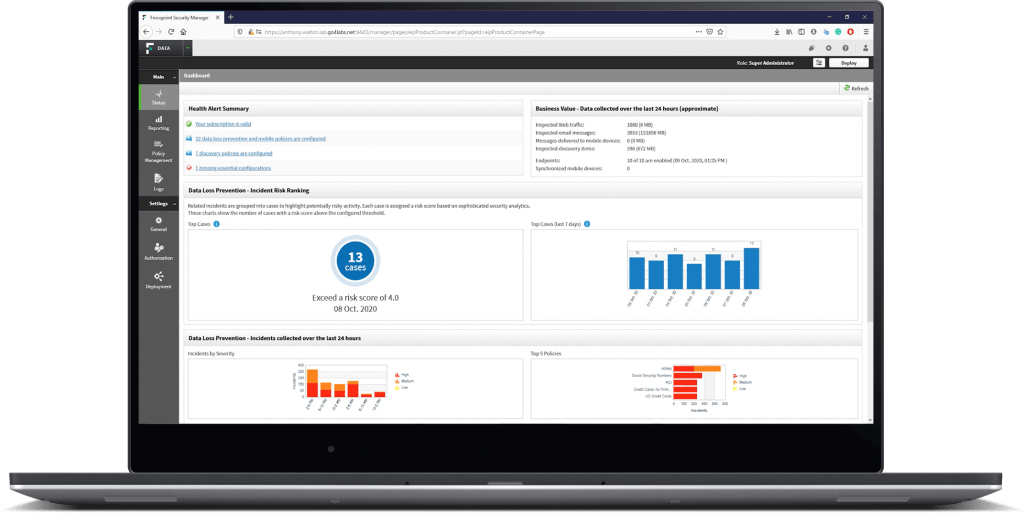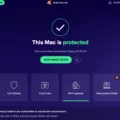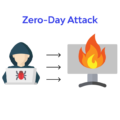Data protection is an increasingly important concern for businesses of all sizes, and Forcepoint Data Loss Prevention (DLP) is a comprehensive solution that can help organizations protect their sensitive data. By combining advanced analytics and integrated risk-adaptive protection, Forcepoint DLP enables organizations to discover, classify, monitor, and protect data intuitively without sacrificing user experience.
Forcepoint DLP Endpoint provides security administrators with the ability to block or monitor and log files that are in breach of policy, creating forensic monitoring capabilities that allow full visibility into content traffic without restricting device usage. The platform also protects organizations from internal and external data loss through gates at the perimeter and within the organization, as well as on certain Infrastructure as a Service (IaaS) platforms.
Forcepoint DLP uses an analytics engine to identify high-risk incidents and rank them according to severity. This allows organizations to quickly respond to threats before they become major problems. With Forcepoint DLP, organizations can benefit from:
• Comprehensive Data Security – Proactively prevent data loss with advanced detection capabilities at the perimeter and within an organization.
• Automated Risk Analysis – Automatically analyze risk factors associated with each incident for faster response times.
• Increased Visibility & Control – Get complete visibility into content traffic on devices without restricting device usage.
• Real-Time Auditing – Monitor behavior in real-time with Risk-Adaptive Protection to stop data loss before it occurs.
• Detailed Reports & Alerts – Create detailed reports on incidents and send out alerts when a policy breach is detected.
Forcepoint DLP is an essential part of any company’s overall security strategy and can help protect against information leaks and data loss due to malicious activities or human error. With its comprehensive protection capabilities, innovative analytics engine, real-time auditing tools, and detailed reporting features, Forcepoint DLP helps organizations stay ahead of threats before they become costly breaches or disasters.

Forcepoint DLP: An Overview
Forcepoint Data Loss Prevention (DLP) is a comprehensive suite of security solutions designed to help organizations protect their sensitive data and ensure compliance with applicable laws and regulations. It helps businesses discover, classify, monitor, and protect data and audit user behavior in real-time using Risk-Adaptive Protection technology. This cloud-based system provides granular control over the movement of sensitive information both within an organization’s internal systems as well as across external networks or the internet. Additionally, Forcepoint DLP provides reporting capabilities to help organizations identify potential security issues or data breaches quickly and accurately.
Forcepoint DLP Endpoint: How Does it Work?
Forcepoint DLP Endpoint is a comprehensive data security solution that helps organizations protect against the loss of sensitive data. It works by enabling administrators to define and enforce policies to monitor, block, or log confidential files that present a policy breach. It provides real-time visibility into data access and usage patterns as well as detailed forensic monitoring to track how files are used. Administrators can create policies that don’t restrict device usage but allow full visibility of content traffic while maintaining compliance with industry regulations and standards. Additionally, it includes automated threat detection and response capabilities, ensuring the rapid identification of potential threats.
Forcepoint DLP Capabilities
Forcepoint DLP is a comprehensive data loss prevention (DLP) solution that enables organizations to protect their confidential data and intellectual property from unauthorized access, misuse, and theft. It combines advanced analytics with policy-based controls to identify, monitor, and protect sensitive information both inside and outside the perimeter.
Forcepoint DLP provides organizations with an array of capabilities that help them protect their confidential data. These include:
• Detecting the intentional or unintentional transmission of sensitive data both inside and outside the organization
• Automating policy enforcement through customizable rules
• Using machine learning algorithms to identify high-risk incidents
• Monitoring network traffic for unusual patterns or behaviors
• Tracking user activities to detect suspicious activities or violations of policies
• Providing detailed audit logs for incident investigations.
Forcepoint DLP also integrates with certain Infrastructure as a Service (IaaS) platforms such as Microsoft Azure and Amazon Web Services (AWS), allowing organizations to extend their protection to these cloud environments. The solution is also available on mobile devices, enabling administrators to control how mobile users access corporate data.
The Use of Data Loss Prevention (DLP)
DLP is used to protect sensitive infrmation from being accessed, shared, or accidentally lost. It can monitor and protect data both at rest (stored) and in transit (moving). DLP works by identifying, classifying, and protecting data based on the organization’s security policies. For example, it can detect when sensitive information such as customer social security numbers or corporate financial records is being transferred over the network in an unauthorized manner. It can also monitor access to files stored on servers, endpoints, and cloud services as well as detect potential insider threats. Additionally, DLP solutions may include encryption of data both at rest and in transit to further protect it from unauthorized access.
The Purpose of Forcepoint
The purpose of Forcepoint is to provide organizations with comprehensive user and data security solutions that protect against the increasing risks of cyber threats while enabling digital transformation and growth. Our innovative solutions are designed to keep up with the ever-evolving threat landscape, providing real-time protection that stops malicious actors from accessing sensitive data and systems. Additionally, our solutions enable employees to collaborate securely, allowing them to create value without compromising the safety of their organization. With Forcepoint’s cutting-edge cybersecurity solutions, organizations can rest assured that their data is secure and their business is protected.
Deploying a Forcepoint DLP
Deploying a Forcepoint DLP system is an important task that requires careful planning and preparation. The following steps outline the general process of deploying a Forcepoint DLP system:
1. Prepare your environment – Before you begin, make sure you have the necessary hardware and software requirements in place for your deployment. This includes ensuring that all machines on which the DLP agent will be installed have the correct Windows operating system version, the correct .NET framework version, and any other platform dependencies that may be required.
2. Download the DLP Agent – You will need to download the Forcepoint DLP Agent from our website, then save it to a location on each machine that needs to be protected by DLP.
3. Install the DLP Agent – Once downloaded, begin installing the DLP Agent on each machine using either a manual install or automated install process through System Center Configuration Manager (SCCM).
4. Configure your policies – Create and configure your custom policies within our web-based policy manager console. This includes specifying which users or groups should receive what type of protection based on their roles within your organization.
5. Monitor your system – After completing the installation, it is important to regularly monitor your Forcepoint DLP system for any changes or activity that could potentially compromise its security or effectiveness.
By following these steps and taking proper precautions during deployment, you can ensure that your Forcepoint DLP system is properly implemented and deployed in order to maximize its effectiveness in protecting against data loss and unauthorized access attempts.
Forcepoint DLP Components Overview
Forcepoint DLP is a comprehensive data loss prevention (DLP) solution that helps organizations protect their sensitive data from accidental or malicious data leaks. It includes components such as policy-based content control, audit logging, and reporting capabilities to monitor and control the use of confidential information. Additionally, Forcepoint DLP offers advanced features for identifying and preventing data breaches by utilizing fingerprinting technology and machine learning algorithms. Enterprises can customize their deployment options depending on their IT environment needs. Furthermore, Forcepoint DLP provides pre-defined regulatory policy templates for easy implementation and maintenance. All this is managed from a single point of control, making it an ideal solution for organizations looking to ensure the security of their critical information.
The Benefits of Endpoint Protection with DLP
DLP Endpoint Protection is a security solution designed to protect sensitive data stored on endpoint devices (such as laptops, desktops, and mobile devices). It does this by monitoring user activity and identifying potential risks associated with the transfer of confidential data. Endpoint DLP solutions can be used to detect unusual activities such as unauthorized file transfers, suspicious network traffic, or an abnormal number of login attempts. Advanced endpoint DLP solutions also offer additional layers of protection such as encryption, device control, and access control that can help to ensure that only authorized users are accessing your data. By combining these measures, DLP Endpoint Protection provides comprehensive protection for sensitive information stored on endpoint devices.
The Benefits of Using DLP
Data Loss Prevention (DLP) is a system designed to protect data on a computer or network by preventing unauthorized access, modification, or removal of sensitive information. It provides organizations with greater control over the data they possess and helps to ensure that only authorized users can access sensitive information. The main advantage of DLP is that it can help organizations protect their valuable data from accidental or malicious loss and misuse.
DLP can help an organization identify where its sensitive data is located and establish policies around its use. It can also detect attempts to copy or send out sensitive information and alert the organization when this type of activity occurs. Additionally, DLP can be used to monitor for suspicious activity, such as unexpectedly large transfers of data, which could indicate a potential breach.
Overall, the main benefit of DLP is that it provides organizations with the ability to better protect their sensitive data from unauthorized access and misuse. By identifying where their sensitive data is located and establishing policies around its use, organizations can take proactive steps toward security and compliance.
Examples of Data Loss Prevention (DLP)
Data Loss Prevention (DLP) is an approach to protecting sensitive data from unauthorized use, access, or disclosure. It is typically implemented by combining technologies and policies that work together to identify, monitor, and protect confidential information.
Technologies commonly used for DLP include endpoint detection and response (EDR), network monitoring, content analysis tools, encryption, and authentication measures. Policies help to ensure that these technologies are used in a manner that aligns with organizational objectives and goals.
For example, organizations can configure user workstations to block the use of USB devices or create a formal policy regarding the sharing of confidential data via email. By using these measures together, organizations can better protect their data and reduce the risk of data breaches.
Comparing Endpoint DLP and Network DLP
Endpoint Data Loss Prevention (EDLP) is a technology used to protect sensitive data from leaving an organization’s endpoint devices, such as laptops or tablets. Endpoint DLP solutions are typically deployed as software applications on the endpoint device and use policies to identify and block sensitive data from being sent outside of the organization.
Network Data Loss Prevention (NDLP) is a technology used to monitor network traffic within an organization to detect and prevent the unauthorized transfer of sensitive data outside the organization. Network DLP solutions are typically deployed as software agents on corporate servers and use policies to identify and block sensitive data from being sent out of the organization. Unlike EDLP, NDLP can detect sensitive data as it flows across multiple systems and networks in real-time, providing organizations with greater visibility into their networks.
Conclusion
In conclusion, Forcepoint DLP is a comprehensive data loss prevention solution that provides businesses with the necessary tools to protect their sensitive data. It allows for real-time audit behavior, Risk-Adaptive Protection to stop data loss, and forensic monitoring so security administrators can create policies without restricting device usage. Moreover, it protects organizations from information leaks and data loss at the perimeter and inside the organization as well as in certain Infrastructure as a Service platforms. Its analytics engine can also identify and rank high-risk incidents. With Forcepoint DLP, businesses have an effective way to secure their data from breaches, exfiltration transmissions, and unauthorized use.








